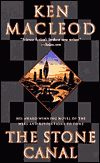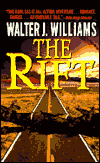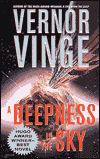
The Stone Canal, by Ken MacLeod
Book Review by Richard R. Horton
Have you read this book?
It's long been true that a lot of the best SF comes from British or UK-based writers. Nowadays, frustratingly for those of us in the US, a lot of very fine SF is being published first in the UK and not until much later in the US. (Iain M. Banks, Greg Egan, and Terry Pratchett are examples of this.) Worse, some fine stuff doesn't seem to get published here at all! (Many of Iain Banks' supposedly non-SF novels and Tom Holt's later comic fantasies, for instance.) Now here comes another British writer, and a very impressive one on the evidence of this novel.
The Stone Canal is MacLeod's second novel. It is apparently related to his first novel, The Star Fraction, and his third novel, The Cassini Division, but I am told it can be read without difficulty on its own, and I found it to stand alone just fine.
At a first brush, MacLeod reads like "Iain Banks meets Bruce Sterling". The novel's opening, with a somewhat smart-alecky "human- equivalent" robot briefing a confused newly-awakened man, and its structure, alternating chapters on different timelines, definitely echo some of Banks' work. (Note that Banks acknowledges MacLeod's help with Use of Weapons, in terms which suggest to me that he may have helped with that book's unusual structure.) The deeply political concerns, and central character's habit of talking at length about politics, as well as some of the technology and the attitude towards technology, reminded me of Sterling (and also, in a different way, Kim Stanley Robinson. Which is to say, at times this book is a bit talky.) But in the final analysis, The Stone Canal is a very original, very impressive novel. It's true SF, chock full of sense of wonder concepts, interested in new technology, in future politics, and in how technology affects politics (and human life in general).
The novel opens with a man awakening in the desert of a Mars-like planet, accompanied by a "human-equivalent" robot. Soon we meet another robot, Dee Model, this one a "gynoid" (female android), who has escaped her owner (for whom she was a sex toy), and is proclaiming her autonomy. The man is soon revealed to be Jonathan Wilde, a legendary figure of political resistance among the inhabitants of New Mars, and the gynoid is based on a clone of Wilde's long-dead wife. The two encounter each other, and both end up in the hands of the "abolitionist" movement, which favors freeing intelligent robots from human slavery. Soon they are jointly involved in lawsuits brought by Dee Model's owner, who is Wilde's friend, long time rival, and apparent murderer, Dave Reid.
This seems like plenty of background for a novel in itself, especially given the interesting environment of New Mars, with its single City, 5/6 of which is given over to "wild machines", and with the pervasive semi-VR technology, the grounds for speculation about the nature of human vs. machine intelligence, and the semi-anarchist political structure of the colony. But in parallel tracks we follow the early life, on roughly present-day Earth, of Jonathan Wilde, Dave Reid, and the two important women in their lives: Myra and Annette. Reid is a diehard Trotskyite socialist, and Wilde an anarchist and "space nut"; and the tension between their political views, as well as the tension resulting from their relationships with the two women, is followed over the decades. Both men become very powerful in the decaying near-future environment; as both in their ways push to open up space travel for people in general.
The two timelines inevitably converge, and the real concern of the novel comes clear: understanding of the nature of the "fast folk" (originally human simulations run on very fast computer hardware), and understanding the link between New Mars and Earth. MacLeod speculates fascinatingly on nanotechnology, virtual reality, and astrophysics. Everything is well-tied together in the end, although in a slightly disappointing manner. (This is one way in which I rather suspect reading The Star Fraction might improve this novel, as I gather it may show some more of the nature of MacLeod's future - the first and last lines of The Stone Canal, by the way, are both stunners, if a bit contrived also, as overtly "stunning" lines often are.) The characters of Wilde and Reid are very well presented, though the female characters are a bit sketchier. The novel's weaknesses are an occasional tendency to talkiness, the rather familiar setup of the relationship of the main characters, along with their realization of enormous political power, and the slight flatness of the ending. But all in all this is an excellent pure SF novel, and one which bodes well for a career to watch.
The Stone Canal is MacLeod's second novel. It is apparently related to his first novel, The Star Fraction, and his third novel, The Cassini Division, but I am told it can be read without difficulty on its own, and I found it to stand alone just fine.
At a first brush, MacLeod reads like "Iain Banks meets Bruce Sterling". The novel's opening, with a somewhat smart-alecky "human- equivalent" robot briefing a confused newly-awakened man, and its structure, alternating chapters on different timelines, definitely echo some of Banks' work. (Note that Banks acknowledges MacLeod's help with Use of Weapons, in terms which suggest to me that he may have helped with that book's unusual structure.) The deeply political concerns, and central character's habit of talking at length about politics, as well as some of the technology and the attitude towards technology, reminded me of Sterling (and also, in a different way, Kim Stanley Robinson. Which is to say, at times this book is a bit talky.) But in the final analysis, The Stone Canal is a very original, very impressive novel. It's true SF, chock full of sense of wonder concepts, interested in new technology, in future politics, and in how technology affects politics (and human life in general).
The novel opens with a man awakening in the desert of a Mars-like planet, accompanied by a "human-equivalent" robot. Soon we meet another robot, Dee Model, this one a "gynoid" (female android), who has escaped her owner (for whom she was a sex toy), and is proclaiming her autonomy. The man is soon revealed to be Jonathan Wilde, a legendary figure of political resistance among the inhabitants of New Mars, and the gynoid is based on a clone of Wilde's long-dead wife. The two encounter each other, and both end up in the hands of the "abolitionist" movement, which favors freeing intelligent robots from human slavery. Soon they are jointly involved in lawsuits brought by Dee Model's owner, who is Wilde's friend, long time rival, and apparent murderer, Dave Reid.
This seems like plenty of background for a novel in itself, especially given the interesting environment of New Mars, with its single City, 5/6 of which is given over to "wild machines", and with the pervasive semi-VR technology, the grounds for speculation about the nature of human vs. machine intelligence, and the semi-anarchist political structure of the colony. But in parallel tracks we follow the early life, on roughly present-day Earth, of Jonathan Wilde, Dave Reid, and the two important women in their lives: Myra and Annette. Reid is a diehard Trotskyite socialist, and Wilde an anarchist and "space nut"; and the tension between their political views, as well as the tension resulting from their relationships with the two women, is followed over the decades. Both men become very powerful in the decaying near-future environment; as both in their ways push to open up space travel for people in general.
The two timelines inevitably converge, and the real concern of the novel comes clear: understanding of the nature of the "fast folk" (originally human simulations run on very fast computer hardware), and understanding the link between New Mars and Earth. MacLeod speculates fascinatingly on nanotechnology, virtual reality, and astrophysics. Everything is well-tied together in the end, although in a slightly disappointing manner. (This is one way in which I rather suspect reading The Star Fraction might improve this novel, as I gather it may show some more of the nature of MacLeod's future - the first and last lines of The Stone Canal, by the way, are both stunners, if a bit contrived also, as overtly "stunning" lines often are.) The characters of Wilde and Reid are very well presented, though the female characters are a bit sketchier. The novel's weaknesses are an occasional tendency to talkiness, the rather familiar setup of the relationship of the main characters, along with their realization of enormous political power, and the slight flatness of the ending. But all in all this is an excellent pure SF novel, and one which bodes well for a career to watch.
| The Stone Canal, by Ken MacLeod on Amazon |
The Stone Canal, by Ken MacLeod on Amazon

Comment on The Stone Canal, by Ken MacLeod
| Comments on The Stone Canal, by Ken MacLeod |
| There are no comments on this book. |



